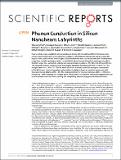| dc.contributor.author | Park, Woosung | |
| dc.contributor.author | Romano, Giuseppe | |
| dc.contributor.author | Ahn, Ethan C. | |
| dc.contributor.author | Kodama, Takashi | |
| dc.contributor.author | Park, Joonsuk | |
| dc.contributor.author | Barako, Michael T. | |
| dc.contributor.author | Sohn, Joon | |
| dc.contributor.author | Kim, Soo Jin | |
| dc.contributor.author | Cho, Jungwan | |
| dc.contributor.author | Marconnet, Amy M. | |
| dc.contributor.author | Asheghi, Mehdi | |
| dc.contributor.author | Kolpak, Alexie M. | |
| dc.contributor.author | Goodson, Kenneth E. | |
| dc.date.accessioned | 2018-02-15T16:03:40Z | |
| dc.date.available | 2018-02-15T16:03:40Z | |
| dc.date.issued | 2017-07 | |
| dc.date.submitted | 2017-03 | |
| dc.identifier.issn | 2045-2322 | |
| dc.identifier.uri | http://hdl.handle.net/1721.1/113683 | |
| dc.description.abstract | Here we study single-crystalline silicon nanobeams having 470 nm width and 80 nm thickness cross section, where we produce tortuous thermal paths (i.e. labyrinths) by introducing slits to control the impact of the unobstructed "line-of-sight" (LOS) between the heat source and heat sink. The labyrinths range from straight nanobeams with a complete LOS along the entire length to nanobeams in which the LOS ranges from partially to entirely blocked by introducing slits, s = 95, 195, 245, 295 and 395 nm. The measured thermal conductivity of the samples decreases monotonically from ∼47 W m⁻¹ K⁻¹ for straight beam to ∼31 W m⁻¹ K⁻¹ for slit width of 395 nm. A model prediction through a combination of the Boltzmann transport equation and ab initio calculations shows an excellent agreement with the experimental data to within ∼8%. The model prediction for the most tortuous path (s = 395 nm) is reduced by ∼14% compared to a straight beam of equivalent cross section. This study suggests that LOS is an important metric for characterizing and interpreting phonon propagation in nanostructures. | en_US |
| dc.description.sponsorship | National Science Foundation (U.S.) (Grant 1336734) | en_US |
| dc.description.sponsorship | United States. Department of Energy. Office of Basic Energy Sciences (Award DE-SC0001299) | en_US |
| dc.description.sponsorship | United States. Department of Energy. Office of Basic Energy Sciences (Award DE-FG02-09ER46577) | en_US |
| dc.publisher | Nature Publishing Group | en_US |
| dc.relation.isversionof | http://dx.doi.org/10.1038/S41598-017-06479-3 | en_US |
| dc.rights | Creative Commons Attribution 4.0 International License | en_US |
| dc.rights.uri | https://creativecommons.org/licenses/by/4.0/ | en_US |
| dc.title | Phonon Conduction in Silicon Nanobeam Labyrinths | en_US |
| dc.type | Article | en_US |
| dc.identifier.citation | Park, Woosung et al. “Phonon Conduction in Silicon Nanobeam Labyrinths.” Scientific Reports 7, 1 (July 2017): 6233 © 2017 The Author(s) | en_US |
| dc.contributor.department | Massachusetts Institute of Technology. Department of Mechanical Engineering | en_US |
| dc.contributor.mitauthor | Romano, Giuseppe | |
| dc.contributor.mitauthor | Kolpak, Alexie M. | |
| dc.relation.journal | Scientific Reports | en_US |
| dc.eprint.version | Final published version | en_US |
| dc.type.uri | http://purl.org/eprint/type/JournalArticle | en_US |
| eprint.status | http://purl.org/eprint/status/PeerReviewed | en_US |
| dc.date.updated | 2018-02-09T17:41:23Z | |
| dspace.orderedauthors | Park, Woosung; Romano, Giuseppe; Ahn, Ethan C.; Kodama, Takashi; Park, Joonsuk; Barako, Michael T.; Sohn, Joon; Kim, Soo Jin; Cho, Jungwan; Marconnet, Amy M.; Asheghi, Mehdi; Kolpak, Alexie M.; Goodson, Kenneth E. | en_US |
| dspace.embargo.terms | N | en_US |
| dc.identifier.orcid | https://orcid.org/0000-0002-4347-0139 | |
| mit.license | PUBLISHER_POLICY | en_US |
